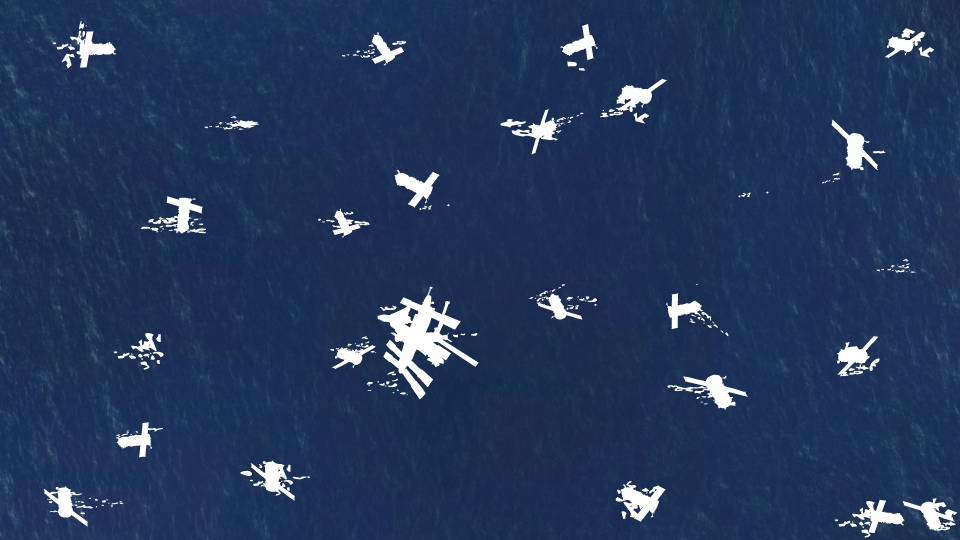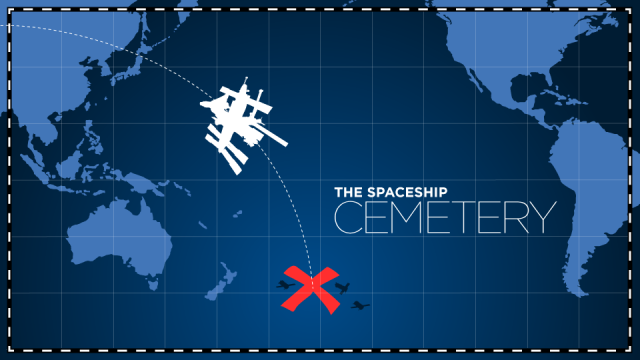In a remote stretch of the Pacific Ocean southeast of New Zealand, the broken remains of space stations and robotic freighters litter the ocean floor, 4km below the waves. The world’s space agencies call this region the South Pacific Ocean Uninhabited Area. But it’s also called the Spacecraft Cemetery.
There are no islands in these waters, the nearest shores are thousands of kilometres away, and shipping traffic is relatively light here. It’s an ideal place for spacecraft to plunge back to Earth and die, far from any humans that might be injured by falling debris.
Isolated Waters
This lonely region is near Point Nemo, the point in the ocean which is furthest from any land mass. Named for Captain Nemo of Jules Verne’s classic sci-fi novel 20,000 Leagues Under the Sea, this point sits at 48⁰25.6′ South latitude and 123⁰23.6′ West longitude — to reach land, you’d have to go 2700km south to Antarctica.
These aren’t just the home waters of the fictional Lincoln Island, Captain Nemo’s last stronghold and the hidden port of the submarine Nautilus. H.P. Lovecraft’s Cthulhu mythos also puts the sunken nightmare city of R’lyeh not too far from Point Nemo, right in the middle of the Spacecraft Cemetery.

Spaceship Wrecks
The Spacecraft Cemetery is the final resting place of 145 of Russia’s Progress autonomous resupply ships, four of Japan’s HTV cargo craft, and five of the ESA’s Automated Transfer Vehicles. Six Russian Salyut space stations and the venerable Mir space station lie alongside the freighters that once supplied them.
There’s a lot of space history down there, but of course, none of these spacecraft are just sitting neatly on the ocean floor in one piece. Or even two pieces. Re-entering the Earth’s atmosphere is a violent, destructive process for any object that tries it, whether it’s a meteor or a space station. Plunging into the atmosphere at high speed generates enough heat to burn up even rock or metal. That’s why so few large meteors make it to Earth; most of their mass burns away as they fall through the atmosphere. That’s also why piloted vehicles like the Space Shuttle or the Soyuz capsules are built with thermal shielding, to protect the spacecraft and its occupants on the way down.
Autonomous spacecraft like the Progress or ATV cargo ships weren’t built to survive re-entry, so the heat of hitting the atmosphere is inevitably fatal. The first of the ESA’s ATV ships, the aptly named Jules Verne, broke up about 75km above the Spacecraft Cemetery on September 29, 2009. It took 12 minutes for the remaining fragments of Jules Verne to splash into the Pacific. NASA observed Jules Verne‘s fiery interment from two planes, a DC-8 and a Gulfstream jet, along the re-entry path, which means you can watch this video of a spacecraft’s final descent, shot from midair.
So far, the largest denizen of this undersea graveyard is the Mir, the 130-tonne Russian space station which made its final dive in March of 2001, after 15 years in orbit. It started to break up about 95km in the air, and by the time it had fallen to 85km, the space station’s peripheral components had been ripped away, and its main structure had been to collapse. In the end, only 18-22 tonnes of Mir debris made it to the ocean, broken into about six main fragments.
You can watch an animation of the whole event here.
So the Space Age’s watery tomb contains only broken, twisted, and burned fragments of the spacecraft that once orbited our planet.
Mariners, Beware
Those high-tech remains are spread out over a huge distance. The South Pacific Ocean Uninhabited Area stretches about 3000km from north to south, by about 5000km from west to east. And any given spacecraft can scatter debris over a huge swath of ocean. Mir left a debris trail 3000km long and 100km wide when it went down.
“Even in controlled entries, this will not be a point landing,” explained Holger Krag, head of ESA’s Space Debris Office, in late 2013, just before the ESA’s third ATV, Edoardo Amaldi, joined its predecessors in the deep. “The nature of this break up process brings it that we will have to clear quite a large area to make sure that all fragments will fall within the designated area, because they will not fall in one spot.”
A few days before a spacecraft’s de-orbit, the space agency who owns the spacecraft will notify aviation and maritime authorities in Chile and New Zealand, who share responsibility for traffic in the remote stretch of ocean. They offer information about expected re-entry times and where debris is likely to fall. Then the craft can begin its controlled plunge through the atmosphere to its final interment in these waters. It’s up to the aviation and maritime authorities to issue notices to pilots and merchant vessels, warning them to avoid the area.
On Bottom of the Sea
The Spacecraft Cemetery lies on the boundary between the bathyal zone and the abyssal zone, 4km beneath the waves. It’s dark here, because no sunlight penetrates water this deep. Few fish live this far down; these depths are home to sponges, sea stars, squid, octopi, whales and viperfish. Temperatures hover between 2C and 4C. For ships used to the cold and darkness of space, it just might feel like home.
